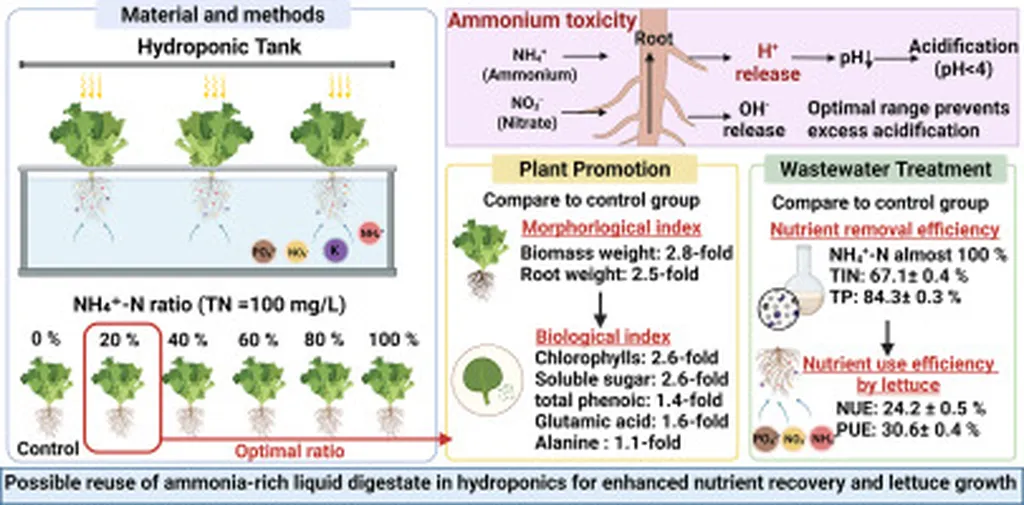In the ever-evolving landscape of agriculture, understanding how plants respond to varying nutrient levels is crucial for optimizing crop yield and quality. A recent study published in the *Journal of Agriculture and Food Research* has shed new light on how nitrogen (N) availability influences the growth and polyphenolic content of red lettuce varieties. The research, led by Muhammad Khalid Hameed from the School of Agriculture and Biology at Shanghai Jiao Tong University, employed a multi-omics approach to unravel the complex interplay between nitrogen levels and flavonoid biosynthesis in red lettuce.
Nitrogen is a vital macronutrient that plays a pivotal role in plant growth and development. However, its impact on biomass accumulation and polyphenolic biosynthesis in red lettuce has remained largely unexplored until now. Hameed and his team investigated two distinct red lettuce cultivars, H20K7044 and H20K3447, under three different nitrogen treatments: high_N (10 mmol L−1), low_N (2.5 mmol L−1), and normal_N (5 mmol L−1).
The study revealed that elevated nitrogen supply significantly enhanced growth parameters in the H20K7044 cultivar, including chlorophyll content and fresh/dry biomass. In contrast, the H20K3447 cultivar exhibited a higher nitrogen balance index (NBI) under high nitrogen conditions. Intriguingly, the H20K7044 cultivar showed high relative flavonol contents under low nitrogen treatment, suggesting a cultivar-specific response to nitrogen availability.
By integrating metabolomics and transcriptomic analyses, the researchers identified key biosynthetic modification reactions and correlated transcriptomic profiles with metabolite networks across different nitrogen treatments. “This multi-omics framework allowed us to dissect the complex regulatory mechanisms underlying flavonoid biosynthesis in response to nitrogen availability,” Hameed explained.
Comparative analysis revealed significant upregulation of key structural genes in flavonoid biosynthesis, such as PAL (phenylalanine ammonia lyase), CHI (chalcone isomerase), ANS (anthocyanidin synthase), DFR (dihydroflavonol 4 reductase), FLS (flavonol synthase), and F3′H (flavonoid 3′-hydroxylase), under low nitrogen conditions in both red lettuce cultivars. Metabolomic profiling further highlighted the differential accumulation of polyphenolic derivatives, including kaempferol 4′-glucoside, quercetin 3-O-(6″-acetyl-glucoside), cyanidin-3-O-glucuronide, and epicatechin-3-O-gallate, which varied with nitrogen availability and genotypic background.
The findings of this study establish a novel framework for interrogating nitrogen-mediated regulation of polyphenolic biosynthesis, linking transcriptional activity to metabolic flux in red lettuce cultivars. “This research underscores the utility of multi-omics integration in dissecting genotype-environment interactions, offering actionable insights for optimizing nitrogen fertilization strategies,” Hameed noted.
The implications of this research are far-reaching for the agriculture sector. By understanding how different lettuce cultivars respond to varying nitrogen levels, farmers and agronomists can tailor nutrient management strategies to enhance phytochemical richness and nutritional quality in lettuce cultivation. This could lead to improved crop resilience and value, ultimately benefiting both producers and consumers.
As the agricultural industry continues to embrace precision agriculture and advanced biotechnological tools, studies like this pave the way for more sustainable and efficient crop management practices. The integration of metabolomics and transcriptomics offers a powerful approach to unraveling the complex interactions between genotype and environment, providing valuable insights for optimizing crop performance and quality.
In the words of Hameed, “This research not only advances our understanding of nitrogen-responsive flavonoid biosynthesis in red lettuce but also sets the stage for future developments in precision agriculture and tailored nutrient management strategies.” As we move towards a more sustainable and resilient agricultural future, such advancements will be instrumental in meeting the growing demands for high-quality, nutritious crops.

